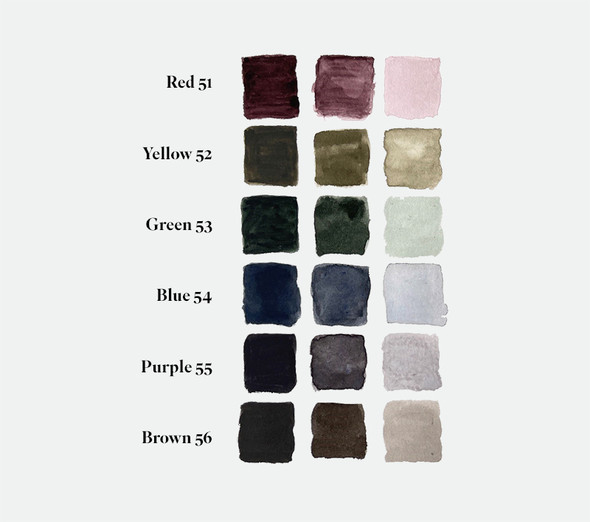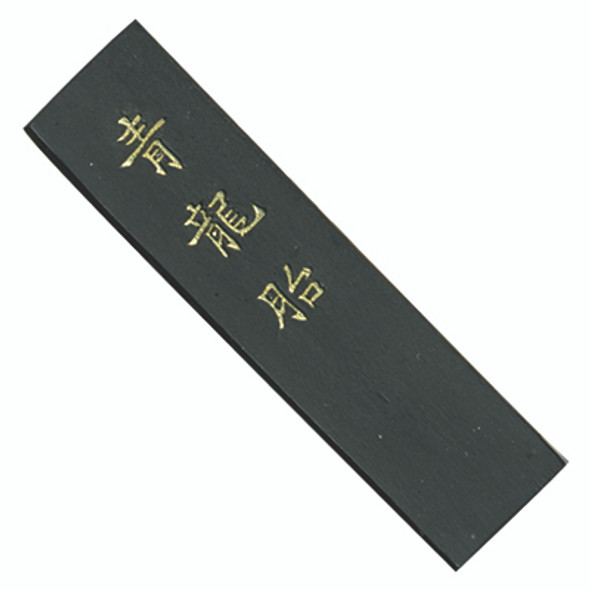Description
IS39. Boko-Undo Saiboku Aya Ink Sticks.
Excellent for calligraphy, both broad edge (Italic, Uncial, Blackletter, Foundational Hand) and pointed pen (Copperplate Script, Engrosser's Script, Spencerian Script, Modern Calligraphy). Easy to grind. Rich, highly pigmented color. The ink sticks are hand-formed, so there is variation in shape. The long narrow shape measures approximately 2.25"x 1"x .25" (5.7 x 2.7 x .7 cm).
Choose Color: (61) White, (62) Shell White, (63) Black, (64) Wine Red, (65) Vermillion, (66) Warm Red, (67) Reddish Yellow, (68) Red Ochre, (69) Ultramarine, (70) Sapphire Blue, (71) Purple, (72) Reddish Purple, (73) Indigo Blue, (74) Fern Green, (75) Forest Green, (76) Ochre, (77) Chrome Yellow, (78) Dark Yellow
The boxes will be marked with the color number prefixed by 152. Colors are only named in Japanese characters.
These colored ink sticks are a professional art supply and not approved for use by children. Avoid ingesting them. Do not use them for face or other body painting.
Reggie Ezell tested the ink sticks with the broad pen; Mike Kecseg tested them with the pointed pen. Some of their product test sheets are shown.
Reggie writes:
Having control of the flow of the ink/paint as it comes off the pen is what I want -- more than anything else -- in a writing fluid. This control allows me to produce crisp strokes; to get good clean lines. To test these new colored inks sticks, I used a pressurized Italic style. The style is especially demanding in terms of ink-flow control. I used five different sizes of Mitchell nibs on 90lb Arches Hot Press Watercolor Paper, most of the time with a light dusting of gum sandarac on the paper. I found that all of the ink sticks performed very well in the entire range of nib sizes. This is not always the case with writing fluids. Sometimes an ink will work better in a larger size, but not so well in a smaller one, or vice versa.
In doing my tests, I ground 16 different colors and put them in mixing pans. I found they reconstitute beautifully and work just like a watercolor or gouache in that regard. All of these new ink sticks seem a bit softer and are easier to grind than the old (and no longer available) ones. That was a pleasant surprise.
I will be recommending these to my students in my classes. Thank you so much for all of your continued support and supplying the best quality materials for us.
Mike writes:
I tried every color stick, and I found them all to be of a very high quality. I particularly liked that they were easy to grind and that it took very little time to grind a nice opaque color. They all flowed easily from the pointed pen, and I was able to keep a nice hairline on the upstrokes. I was pleasantly surprised to find that the White and Off-White sticks also produced an opaque color on dark paper with minimal grinding. I think these Japanese color ink sticks would provide a nice alternative to using gouache when lettering with a pointed nib.
Like Reggie, I tested the ink sticks on Arches Hot Press Watercolor Paper, a natural white paper. My only criticism would be that writing on this paper and using pointed pen scripts, some of the sticks were so close to each other in color that buying a whole set of them would result in near duplication in some of the colors. On a bright white sheet, the difference in color from stick to stick may be more apparent. I did not try mixing different colors together.
2 Reviews
-
Japanese Color Ink Sticks
I have tried many brands of ink sticks for Chinese-Japanese painting. and these are among the best. Easy to grind and good colors.
-
CALLIGRAPHER AND RN
These also came into one of St Louis' local art supply stores, that's where I heard of them. I haven't had a chance to play with them too much, but from what I have done, I really enjoy them. The grind is more consistent than the old ink sticks. I did purchase the round dish for grinding, only 1 side is unglazed. They also have a rectangular stone (white also) and both sides are unglazed so both sides can be used. Glad to see you found them, John! I did find you need to grind the white a bit more than the rest to get a decent opaqueness.


















